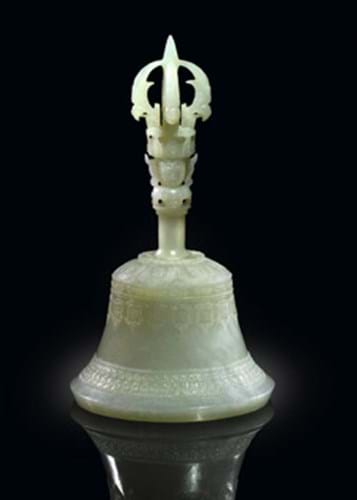
The bell or ghanta, representing the female aspect of wisdom and supreme knowledge, ranks among the most important symbols in Tibetan Buddhism. Together with the delicately carved thunderbolt or vajra surmount, they provide the perfect union of wisdom and compassion, the two principles necessary for attaining enlightenment. The stem is inscribed with a four-character Qianlong (1736-95) reign mark.
An almost identical white jade ghanta resides in the Palace Museum, Beijing while another of a slightly different design is among the Tibetan cultural relics in the collection of the Potala Palace in Lhasa. However, in terms of the market, the best precedent was the imperfect example, again of a slightly differing form, sold in Paris by Beaussant Lefèvre, in November 2005 for a price in the region of £150,000.
The Salisbury ghanta was among a group of Chinese hardstones from Crichel House, Dorset. These ten pieces, sold for a total of £3.6m, were bought from major London dealers half a century ago by Lord Alington and his daughter, the Honourable Mrs Mary Anna Marten.
The bell, lacking only its original 'clapper' that was professionally restored prior to the sale, was pictured in a 1953 album of works of art at Crichel House.
It is believed that most of the pieces from Crichel House were bought by Mrs Marten in 1952 as a celebration for her winning her court case in the so-called Crichel Down affair.
The Crichel Down case concerned a claim by the Martens of unfair treatment by the Ministry of Agriculture and the Crown Lands Commissioners.
Bidding for the £200,000-300,000 estimated lot was effectively a three-way contest between London dealer John Berwald, a telephone bidder and the London-based Chinese art adviser and dealer Qian Weiping.
Mr Qian, seated together with a Beijing-based dealer, proved the major buyer at the sale. In addition to the ghanta, he bought the other seven-figure jade, a pair of Imperial grey-green jade elephants from a throne-room group of the emperor Qianlong.
Each 7 3/4in (17cm) long beast stands four square with its head turned slightly to the side and carries a four-character reign mark. Purchased from Spink & Son, c.1952, these sold for £1m.
Enlivened by a number of a single-owner consignments, including material from the estate of Sackville George Pelham, the 5th Earl of Yarborough, the two-day sale netted just shy of £7.4m, a total that rose to £8.8m when the 19.5 per cent buyer's premium was added.
Confirming the continued strength of the Chinese market at its many levels, this ranks as the largest sale ever conducted by a UK regional fine art auctioneer and betters the £5m total posted by the equivalent event last year.
The Salisbury Salerooms now hold the four of the six highest prices generated by a UK regional saleroom - all for Chinese works of art. In May last year, an Imperial Qianlong spinach-green jade buffalo on its original gilt bronze stand sold at a £3.4m, bettering the firm's previous provincial record of £2.6m (plus 15 per cent buyer's premium) bid for a 14th century Yuan dynasty porcelain double gourd vase in July 2005.
The monumental carving of a buffalo, purchased in 1938 from London dealer John Sparks Ltd for £300, was once owned by Sackville George Pelham.
The seven-figure barrier - a once unimaginable milestone for salerooms outside London - has been passed six times in as many years. The two other occasions were provided by the pair of Fra Angelico panels at Duke's of Dorchester (£1.7m in April 2007) and a Rembrandt self portrait at Gloucestershire's Moore, Allen & Innocent (£2.2m in October 2007).
The buyer's premium was 19.5 per cent.




